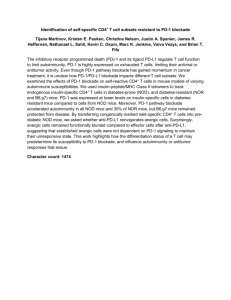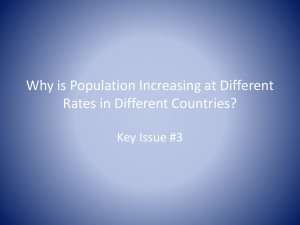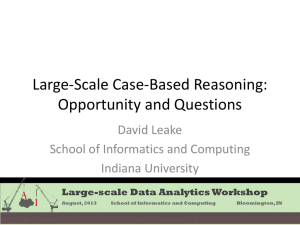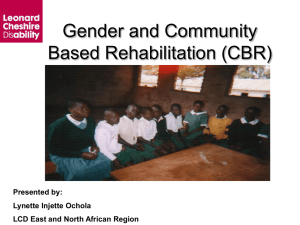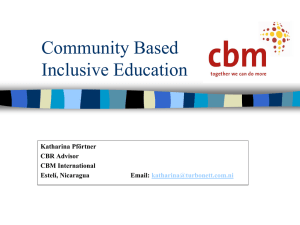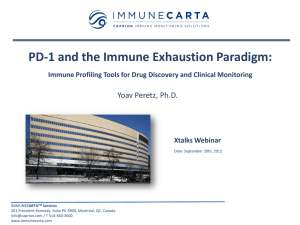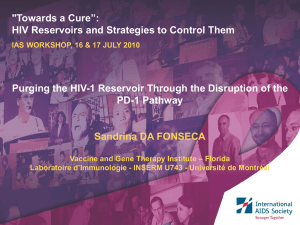Infection of resting CD4 + T cells
advertisement
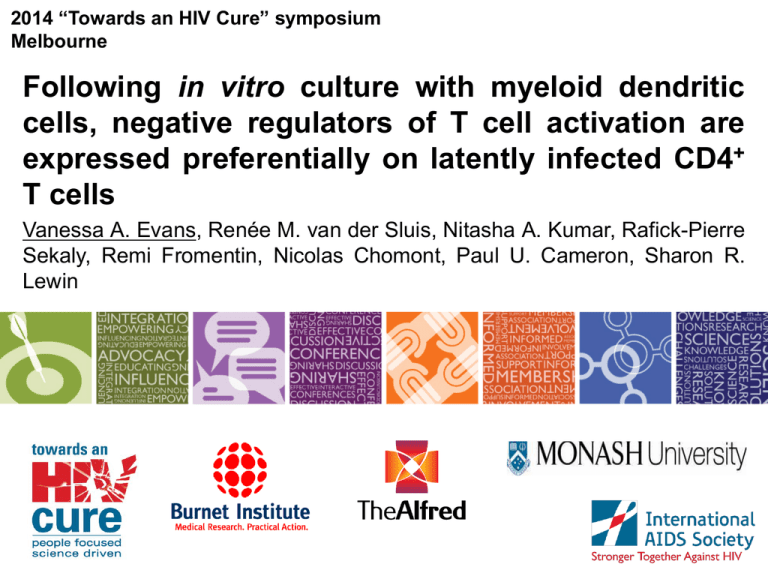
2014 “Towards an HIV Cure” symposium Melbourne Following in vitro culture with myeloid dendritic cells, negative regulators of T cell activation are expressed preferentially on latently infected CD4+ T cells Vanessa A. Evans, Renée M. van der Sluis, Nitasha A. Kumar, Rafick-Pierre Sekaly, Remi Fromentin, Nicolas Chomont, Paul U. Cameron, Sharon R. Lewin Infection of resting CD4+ T cells: a role for cell-cell interactions Resting CD4+ T cell Unactivated resting cells Ex vivo tissue blocks Eckstein et al. J Virology 2001 Endothelial Cells Shen et al. J Virology 2013 Dendritic Cells Evans et al. PLoS Pathogens 2013 Myeloid DC induce latency in resting memory CD4+ T cells L a te n t In fe c tio n P r o d u c tiv e In fe c tio n ** 1000 ** c e lls 1000 ** ns 4 c e lls / 1 0 100 100 10 + 10 EGFP E G F P + c e lls / 1 0 4 c e lls ** <1 A lo n e +pDC +m DC 1 A lo n e +pD C +mD C hi T o ta l C e lls S o rNon-proliferating te d e F lu o r 6 7 0 E G F P ++ CD4 CD4 T T ccells e lls - Not mediated by soluble factors: CCL19, CCL21, CXCL10, IL-10, IL-6 Close DC-T cell proximity required for induction of latency Evans et al. PLoS Pathogens 2013 Negative regulators and latency Negative regulators dampen the immune response and can be found on exhausted T cells Ahmed et al. J Immunol 2010; Day et al. Nature 2006 Latently infected T cells express negative regulators of T cell activation eg. PD-1, Tim-3 and TIGIT Chomont et al. Nat Med 2010; Fromentin et al. CROI 2014 Blocking PD-L1/PD-1 in vivo restores the SIVspecific cellular and humoral immune responses, improves viral control and reduces immune activation Velu et al. Nature 2009; Dyavar Shetty et al. J Clin Invest 2012; Finnefrock et al. J Immunol 2009 Hypothesis Expression of negative regulators during DC-T cell interactions may actively suppress viral replication and maintain latency Resting CD4+ T cells + mouse anti-human CD8, CD11b, CD14, CD16, Resting CD4+ T cells >98% CD4 PBMC Magnetic Bead Depletion CD69 CD19, CD69, HLA-DR CD25 HLA-DR CD3 + mouse anti-human CD3, CD11b, CD19 Bulk DC Plasmacytoid DC CD123 PBMC Magnetic Bead Depletion HLA-DR Dendritic Cells Myeloid DC Lineage Cocktail CD11c Resting CD4+ T cells eFluor 670 DC added 1:10 AND 1 day R5-EGFP-HIV-1 (2h pulse) Non-proliferating eFluor670hi Day 5 p.i. Not productively infected EGFP- eFluor670hiEGFPCD4+ T cells + integrase inhibitor L8 eFluor670 aCD3/aCD28 Activation 3 Days >99% EGFP Productive infection Latent infection Expression of negative regulators following DC-T cell co-culture eFluor-resting CD4+ T cells OR + mDC Baseline PD-1/Tim-3/CTLA-4 1 day R5-EGFP-HIV-1 (2h pulse) Phenotyping on days 1, 2, 3, 4, 5 post-infection CD3 SSC-A FSC-A SSC-H eFluorhiEGFP- T cells eFluor Single cells SSC-W Viable HLA-DR PD-1, Tim-3 and CTLA-4 EGFP Expression of negative regulators following DC-T cell co-culture % Positive cells 50 PD-1 CD4+T cells T cells(+ mDC) 40 30 Mean fold change 32 Tim-3 15 Mean fold change 24 10 20 5 10 0 0 n=3 BL 1 2 3 4 5 20 CTLA-4 15 No change 10 5 0 BL 1 2 3 BL 1 2 3 Days post-infection Days post-infection % Positive cells 20 4 Days post infection 5 4 5 Differential expression of negative regulator ligands on mDC and pDC % positive DC 100 75 mDC pDC 50 25 0 Ligand Neg Reg PDL1 PDL2 PD-1 Gal9 CD80 Tim3 Leitner PLoS Pathog 2013 CD86 CTLA-4 Are PD-1hi cells enriched for latency? PD-1 hi cells eFluorhiEGFPAnti-PD-1 aCD3/28 +L8 PD-1 lo/- cells Latent infection eFluor670 CD4+ T cells EGFP HIV latency is enriched in PD-1hi cells Latent Infection EGFP+ cells/104 cells 1000 p=0.04 FC range 1.9-7.7 Mean FC = 4.1 100 +1uM L8 10 PD-1hi PD-1lo Sorted memory eFluorhiEGFP- CD4+ T cells HIV latency is enriched in Tim3hi cells F C r a n g e 2 .2 - 6 .4 M e a n F C = 4 .3 1000 4 c e lls /1 0 + 100 EGFP Tim-3 lo/- cells L a t e n t In f e c tio n Anti-Tim-3 c e lls p = 0 .0 4 Tim-3 hi cells eFluorhiEGFPCD4+ T cells +1uM L8 10 T im 3 hi T im 3 lo S o rte d m e m o ry e F lu o r hi - EGFP CD4 + T c e lls Summary Myeloid DC facilitate establishment of HIV latency in resting memory CD4+ T cells via direct infection Negative regulators PD-1 and Tim-3 but not CTLA-4 are upregulated on resting CD4+ T cells upon co-culture with mDC Negative regulator ligands are differentially expressed by mDC and pDC mDC-induced HIV latency is enriched in PD-1hi and Tim-3hi cells Blocking interactions between negative regulators and their ligands EGFP+ productively infected CD4+ T cells PD-1/-L1 blockade PD-1 PD-L1 Cell death virus production immune clearance Latent Infection in sorted eFluorhiEGFPCD4+ T cells Implications mDC may facilitate ongoing latent infection of resting CD4+ T cells leading to replenishment of the reservoir Disrupting the function of PD-1 and/or Tim-3 could potentially be exploited to inhibit replenishment of the reservoir and/or reverse latency Acknowledgements Monash University – – – – – – Sharon Lewin Paul Cameron Renée van der Sluis Nitasha Kumar Suha Saleh Candida da Fonseca AMREP Flow Cytometry – – – – Geza Paukovicks Michael Thompson Jeanne Le Masurier Phil Donaldson VGTI Florida – Rafick Sekaly – Nicolas Chomont – Remi Fromentin University of Melbourne – Damian Purcell
